




This education pack has been produced by Peer Productions - a unique youth arts charity dedicated to using theatre to transform young people’s lives. It is designed to support the learning objectives embedded within the production As I See It by providing you with additional information, resources, and lesson plans. It has been designed for Key Stage 3 students and is made with the National Curriculum in mind.

Nina founded Peer Productions back in 2006 and leads the charity’s creative output and development. She is the charity’s founder trustee as well as our resident playwright and oversees all artistic aspects of the organisation. Nina’s interests lie in the furthering of human rights and she is particularly passionate about improving life changes for often marginalised groups including young people, disabled people and women and girls.
Nina’s most recent plays for Peer Productions include Hidden – a play about self-worth, mental health, and self-harm which is available to stream digitally via Peer’s website and Losing It - a play about coming together and falling apart. Both Hidden and Losing It texts can be purchased from Salamander Street.
Nina is currently researching a PhD at Central School of Speech and Drama exploring how plays can be used to change the way teenagers think and behave in intimate relationships.

Nick graduated from Arts University Bournemouth in 2020, where he studied Acting, whilst nurturing his love for spoken-word poetry. Nick has performed in various plays including Treasure Island, Playhouse Creatures, and plans to take a gig-theatre piece of his own to festivals across the south of England. He has recently become a member of the National Youth Theatre and can’t wait to use his technical skillset to further Peer Production’s digital outreach.
Jay graduated from Peer Productions’ Actor Development Programme in 2017 before going on top study Acting and Community Theatre at East15.

They are an actor, writer and facilitator with specific interest in working with hard to reach groups and developing work exploring challenging issues. Most recently they have been working with Theatre 31 in Cookham Wood Young Offender’s Institute.
Peer Productions’ vision is to use theatre to transform the lives of young people.
Founded in 2006, Peer Productions is an award winning youth arts charity specialising in combining high quality arts practice with peer education. Each year we reach 15,000 young people across the South East of England, enabling them to change the way they think about the issues that most affect them and to make positive life choices. Since the pandemic we have expanded into the digital space. Our work is made with, by, and for young people.
We offer:
Peer offers a FREE one year actor development programme for young actors aged 1823 years. A large number of our young actors go on to top Drama schools including LAMDA, GSA, East 15, Rose Bruford, Royal Welsh College, Central School of Speech & Drama, Lipa, Italia Conti and many more.
We create and tour original educational plays to schools and youth settings which tackle the issues that matter most to young people.
We create and deliver innovative arts projects for vulnerable, marginalised, or hard to reach young people. Most notably our Generation Girls project for Autistic girls and girls with learning disabilities.
We produce innovative digital projects exploring the issues which matter most to young people. Most notably 50 Days: Alone Together, our interactive, improvised miniseries exploring the mental health impact of social isolation during the pandemic.
When we talk about triggers, we mean something that could trigger negative feelings or damaging behaviours. As everyone’s experience is unique, anything could potentially be a trigger and we would encourage you to be mindful if you are aware of something in a young person’s history that could make this topic particularly distressing.
Having said this, we are confident that this play is suitable for a Key Stage 3 audience and there are certain key triggers that we have actively sought to avoid in the play.
• Graphic or realistic violence, including visible blood, gore, or weapons.
• Explicit racial or gendered slurs.
• Graphic or explicit accounts of sexual abuse or any other trauma.
• Any suggestion that carrying a knife can provide protection, and no glorification of criminal activity.
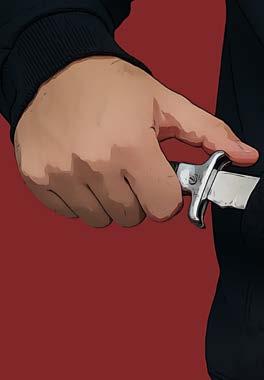
As teachers you will be aware of students who may be potentially more likely to be affected by the content of this play. However, it is important to remember that not all students will have disclosed their personal situations, so all students need to be adequately prepared before seeing the play.
If you are aware of students in the proposed audience who have experience of any of the following, then it may be a good idea to have a more detailed discussion with them in advance:
• They have been affected by knife crime in some way, such as knowing someone who has been a victim or a perpetrator, or having been a victim or perpetrator themselves etc.
• Non-explicit portrayals of a homicide as a result of a stabbing and the emotional impact on the friends and family of the victim.
• Non-explicit portrayals of emergency first aid.
• Discussions relating to being placed in care due to a parent’s illness, and discussions of being a young carer for a vulnerable adult with some references to mental health.
• Characters experiencing racism and sexism and another character stating racist and sexist beliefs.
• They have had experiences of being in care.
• They are a young carer.
• They have been the victim of racist abuse.
It is important to allow these students to make their own informed choices about how or if they see the play. These students, like any others, may well find watching the play enjoyable or cathartic. Many vulnerable people struggle to feel in control of their lives so making the decision to remove them from the experience without consultation might heighten this belief. It is a good idea to give the student some options:
Opting Out: They should be given an opt out option if they want it, without having to justify their absence to their peers. If they take this option you will need to think about how best to follow up with them.
Being seated in a position where they can see the play but discreetly leave and move to a safe space if necessary. This may mean sitting them at the back or on an aisle. Seeing the play without any special arrangements being made. If the student tells you they feel happy to watch the play, then you should let them unless you have any counter information from another source (i.e. mental health team, doctor, parent etc.) In this instance arrange a quiet time to speak with the student after the play to check that they are still okay.
It is crucial that if the play, or the subsequent lessons, have raised concerns for students that they are directed towards support services, both inside and outside school.
Within the Useful Contacts section of this pack, we have listed a variety of resources for both teachers and students to access for further advice and help.
The play opens with a group of teenagers gathering on a street corner. When an argument gets out of control Ali is stabbed by classmate Dainer. Ali’s girlfriend, Kai and his friend Fin phone emergency services and try their best to save him. Taylor films the scene and posts it live to her snapchat, before telling her boyfriend, Dainer, that he needs to leave because the police are coming. Taylor and Dainer both flee.
We flashback to a scene a year previously, where Kai is in the school canteen talking to her mum on the phone. We get the sense that Kai is acting as a young carer for her mum, checking that she has taken her meds and telling her that she will help her when she gets home. Whilst quite upset she walks past Dainer, who tells her to smile. She gets angry at him, rebukes him, and humiliates him. He storms off and ends up retreating to social media where he finds people sharing sexist views that make him feel special and powerful. He ends up sucked into a toxic online culture.
We see another flashback of Ali and Kai becoming a couple and ending up in detention alongside Fin and Taylor. Whilst in detention they start talking about what they would want to do in the future: Taylor wants to be a social media influencer, Fin wants to make music, Ali wants to write stories for video games and Kai talks about wanting to become a social worker. Kai tells them about how her social worker, Heidi, helped her out when her mum was very ill.
In the next flashback, Fin is showing off a new phone to Taylor. Kai enters and is concerned about where he got the phone and finds out that an older girl, Mimi, gave it to him. Kai is familiar with Mimi and thinks she’s manipulative and will take advantage of Fin. It is revealed that Fin is currently in care, but is trying to keep that a secret from everyone else but Kai. She tells him to be careful, but keeps his secret.
We then see Casey, Ali’s sister, witness his stabbing via her snapchat. We flashback to a week ago, when Ali stormed in and was bleeding, having punched a bus stop. He talks about how angry and frustrating it is to constantly be thinking about how to present himself as a black man so as to not become a target, whilst she also talks about her experiences of sexism and how she doesn’t feel safe walking down the street either.
In the present day, we see Dainer washing the blood off his hands in a public toilet. He will later argue that he was a hero for taking someone like Ali off the streets, but we see how he’s spent hours scrolling on his phone alone in his room, with the algorithm creating an echo chamber that has intensified his views and made him believe that he is under attack.
We then flashback to a PSHE lesson on intersectionality and Dainer and Kai end up having an argument about sexism and whether men or women are more disadvantaged in society. Dainer mentions that men are more likely to be victims of violent crimes and are more likely to die by suicide, and claims that women often lie about rape and then men get falsely imprisoned. He then turns on Ali and tells him to “control your woman”, and they square up on each other. Here we see a glimmer of Dainer’s emerging racist views. Afterwards Taylor asks Dainer out for lunch.
In the present Taylor finds Dainer and tells him that he needs to tell the police what has happened. We flashback to a scene with them at lunch time; Dainer is talking about some racist videos that he has sent to Taylor, which falsely claim that people from different ethnic backgrounds are genetically different from each other, and whilst she agrees with him verbally, we know that she doesn’t agree with the videos but doesn’t know how to argue her point. He then thanks her, as he didn’t think he’d manage to get a girl like her as he isn’t an “alpha male”, and she feels special and loved so decides not to say anything about his worrying views.
As Ali is about to head into surgery, we flashback to the scene a week before. Kai, in a panic, rushes in and tells Ali about Fin being in trouble but that she’s managed to fix it. She then shows him the knife in her bag that she took from Fin. She tells Ali that Fin has been staying at Blenheim House, where she had been in care previously whilst her mum was ill, and that there are people in there who are involved with ‘bad stuff’, that Fin has now got caught up with. Fin has been pressured into taking this knife and passing it on to a kid in year 11 but is now at risk of getting caught. In a week he will be with a new foster family, and they don’t want to mess that up for him, so Kai took it off him. Ali points out that she shouldn’t have the knife either as her mum is a vulnerable adult, and then agrees to take the knife to protect them both. Dainer sees this exchange and follows Ali.
In the present, we find out that Ali didn’t survive and that he has died at the age of fourteen. Kai no longer wishes to be a social worker, is suffering from nightmares, and rarely leaves the house. Casey is unable to get over it, and her mum and stepdad divorce, unable to grieve together.
AISI(A5 Document) (1) Taylor has moved schools and is having to think carefully about her influence over others.
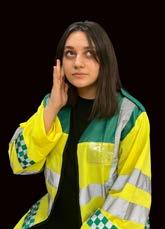
Dainer was convicted of the murder of Ali and is in a juvenile detention centre. Fin has managed to turn his life around, having got support after speaking up about what happened, but he wishes that he spoke up sooner.
The play finishes with the actors remembering 7 young people who have died as a result of knife crime in the UK in recent years.


Ali is a fourteen-year old boy, who is very close to his older half-sister Casey, and loves his girlfriend Kai and wants to protect her. He is funny and wellliked by his friends, Taylor and Fin. As a black boy, he has experienced racial prejudice and discrimination, and finds it difficult to cope with having to constantly think about his conduct in public in order to keep himself safe. When Kai takes the knife to protect Fin, he takes the knife off her in order to protect them both with disastrous consequences.
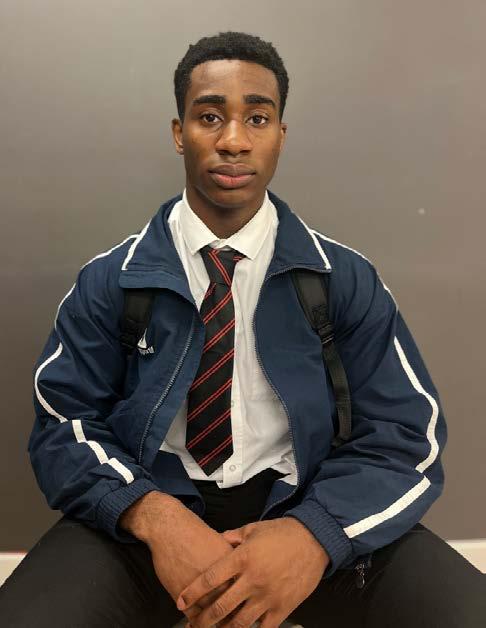
Kai is a fourteen-year old girl, Ali’s girlfriend, and a young carer for her mother. She has previously been in temporary care when her mum was too ill and now wants to be a social worker after her experiences with her own social worker, Heidi. She is the only one that knows that Fin is in care, and has been in the same home as him and is aware that there are people there who are into some bad stuff, including an older girl called Mimi. She is concerned for Fin and when she finds out that he’s been given a knife to hand to another boy, she agrees to take it from him to stop him getting in trouble.

Fin is a fourteen-year old boy, who is friends with Ali, Kai, and Taylor. He is currently in care but is keeping it a secret from everyone but Kai. He has been spending time with an older girl, called Mimi, who has given him a nice new phone. Kai thinks that she will try to manipulate him, but he isn’t worried about this. He then ends up in a situation where he needs to carry a knife and bring it to a boy in year 11, and when he is at risk of getting caught, passes the knife on to Kai instead.
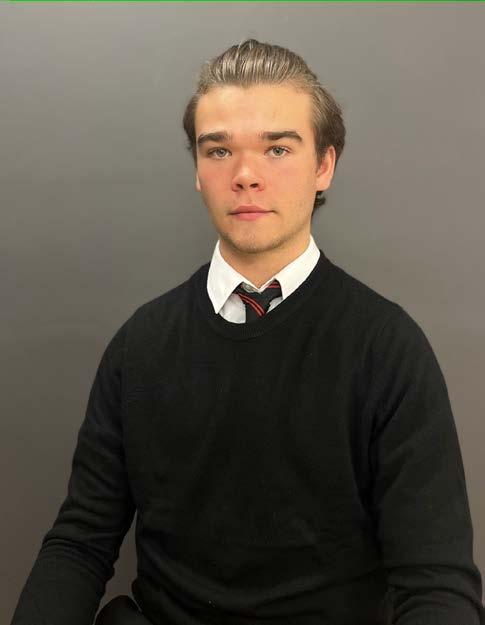
Casey is Ali’s older sister. She cares for her brother a lot and patches him up with the first aid kit when he injures himself and covers for him to their parents when he gets detention. She tries to tell Ali that he needs to try and control his anger, because it will affect the way that people see him, and that people don’t know him like she does. She finds out that her brother has been stabbed when she sees it on snapchat.
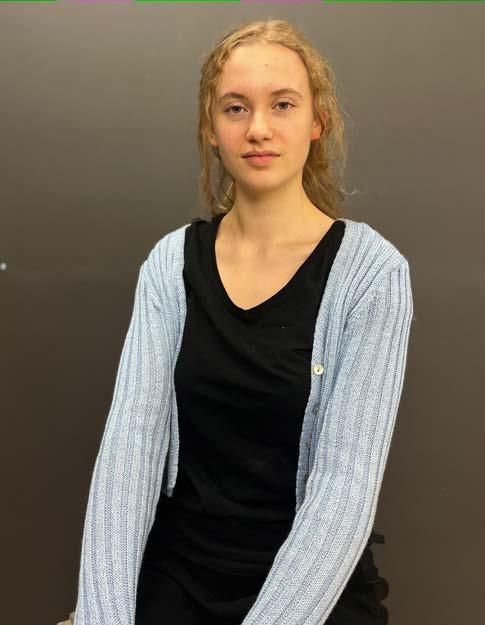
Dainer is a fourteen-year old boy and is Taylor’s boyfriend. He is humiliated by Kai after he tells her to smile, and he ends up getting sucked into a toxic online culture and developing sexist and racist attitudes, that lead him to believing that he is under attack. He is responsible for stabbing Ali after seeing Ali take the knife from Kai, and he runs off before the police can arrive.

Taylor is a fourteen-year old girl, who is friends with Ali, Kai, and Fin, and is also the girlfriend of Dainer. She uses social media a lot and wants to be a social media influencer one day. She loves Dainer but finds his views concerning but doesn’t speak up about it because he makes her feel special and loved. She ends up filming the stabbing and posting it on her snapchat.

County lines is a term used to describe gangs and organised criminal networks involved in exporting illegal drugs into one or more importing areas within the UK, typically from gangs originating from large urban areas who travel to locations elsewhere such as county or coastal towns to sell drugs. The ‘county line’ refers to the use of telephone/mobile numbers circulated to users in a particular area for ordering drugs.
They are likely to exploit children and vulnerable adults to courier drugs and money and they will often use coercion, intimidation, violence (including sexual violence), and weapons to control them. Additionally, these gangs will often attain local property through the act of cuckooing, which is a form of crime in which drug dealers take over the home of a vulnerable person in order to use it as a base for county lines drug trafficking. This is referred to as a ‘trap house’ which will then be used as a base to make and deal drugs in the area.
County lines exploitation can involve force and/or enticement-based methods of compliance and is often accompanied by violence or threats of violence and is typified by some form of power imbalance in favour of those perpetrating the exploitation. The power imbalance could be due to a range of factors, such as age, gender, cognitive ability, physical strength, status, and access to economic or
other resources. Typically within country lines exploitation there is some form of exchange, where the victim is offered something they need or want in exchange for criminal activities. This exchange can include tangible rewards, such as money, drugs, or clothes; or it can be intangible, such as status, protection, or perceived friendship or affection.
There may also be an exchange which involves the prevention of something negative, such as a young person who engages in county lines activity to stop someone carrying out a threat to harm their family.
Child criminal exploitation is a term used to describe the type of exploitation where an individual or group takes advantage of an imbalance of power to coerce, control, manipulate or deceive a child or young person under the age of 18. Whilst criminal exploitation of children goes beyond county lines, it commonly occurs within county lines exploitation. Frequently gangs will seek to recruit children and younger people to courier drugs for them as they are less likely to be picked up by the police and are often easier to control. It is important to realise that it can still be exploitation even if the activity appears consensual.
Gangs often use threats, coercion and violence to force children to do what they want. Gang members are violently punished for making mistakes or not performing to an adequate level, often
involving stabbings, anal injuries caused by jagged objects, and acid attacks. They may also trick children into “debt bondage”, by giving them something and then later demanding repayment for the cost through labour or services.
County lines gangs get children to deliver drugs around the country by using intimidation, debt bondage, violence and/ or grooming. As a result they are often sent to different locations within the UK to carry out tasks for gangs, often without much choice in the manner, and thus it falls within the Modern Slavery Act 2015 as “A person commits an offence if the person arranges or facilitates the travel of another person (“V”) with a view to V being exploited.”
Additionally, children are being forced into ‘trap houses’, where they are forced to cut and sell drugs 24/7, often in unpleasant conditions and under the constant threat of violence with dangerous people coming and going. They earn little money and are often isolated from their friends and family and don’t have the freedom to leave when they want, and can often be forced to move to trap houses in a different area than they start in. They may also become victims of child sexual exploitation as well.
Knife crime includes any crime that involves the use of a sharpened weapon or blade. This includes buying illegal knives, carrying a weapon, threatening someone, or hurting someone. Some types of knives are banned in the UK including lock knives, flick knives, butterfly knives, disguised knives, swordsticks, and gravity knives.
Carrying a knife is a serious offence and you can get a criminal record just for carrying it and a prison sentence of up to 4 years. Carrying a knife for protection is still seen as a crime in the UK. Additionally, carrying a knife increases your likelihood of getting hurt. You are also more likely to be stabbed by your own knife.
Whilst crime has historically been low in Surrey and it remains mostly a safe place to live, there has been a steep increase in the amount of knife related offences being committed. The number of serious knife crime offences has risen more than three times faster in Surrey than anywhere else in England or Wales since 2011.
Offences such as robbery, assault, and murder which involved a blade went up by 632% from 2011 in Surrey. In comparison, there was a proportional decrease in London of 26% over the same period.
14-17 is the most common age range that is being targeted, however children as young as 8 have been victims of this type of exploitation. Gangs specifically target vulnerable children and those who do not have access to support networks, which could include children who:
• Have special educational needs
• Have mental health problems
• Are disabled
• Are experiencing problems at home, such as absent parents or bereavement
• Have been abused
• Are socially isolated
• Are living in poverty
• Have substance misuse issues
• Are in care
• Are homeless or with an insecure accommodation status
• Have a precarious immigration status
• Are excluded from mainstream education
• Have connections with criminality
Gangs are also increasingly looking to recruit ‘clean skins’; i.e. children with no previous criminal record who are unlikely to be stopped by the police, including children without obviously identifiable risk factors.
• Persistently going missing from school or home and/or being found out of the area.
• Unexplained acquisition of money, clothes, or mobile phones etc.
• Excessive receipt of texts/phone calls and/or having multiple handsets
• Relationships with controlling/older individuals or groups
• Suspicion of physical assault/unexplained injuries
• Parental concerns
• Carrying weapons
• Significant decline in school results/performance
• Gang association or isolation from peers or social networks
• Self-harm or significant changes in emotional well-being
Anyone working with a young person who they think may be at risk of child criminal exploitation or radicalisation should follow their local safeguarding guidance and share this information with their local authority’s social services. If you believe a person is in immediate risk of harm, you should contact the police. The first step of your safeguarding process will typically involve contacting your designated safeguarding lead who has the responsibility for linking you in with your local authority’s social services.
This play also deals with the issue of racism, specifically racism experienced by black men and boys within the UK. In the UK it is illegal to discriminate against someone, or treat them differently, because of their race. Racism and racial abuse or bullying can be distressing for children and young people, and can lead to feelings of isolation, depression, anger, or even shame about their race and how they looked. In 2019/20, Childline delivered 547 counselling sessions where racist bullying, racism, or being bullied for spiritual, cultural, or religious reasons were mentioned.
Institutional racism is prevalent within the UK, with black households more likely to experience poverty, experience job losses, and pay cuts, and having higher rates of depression, anxiety, self harm, and suicidal thoughts. Racial abuse in primary schools has also increased by more than 40% in the last decade. In most areas of the country, black individuals are more likely due to institutional racism to exhibit at least one of the risk factors mentioned above for child criminal exploitation.
Black people are more likely to know a victim or knife crime closely or to have been one themselves. However, outside the M25 white people are more likely to know a victim of knife crime closely or to have been one themselves.
Black children are also over four times more likely to be arrested than white children, and black people are now nearly 10 times more likely to be stopped and searched by police than white people, and are far more likely to be sent to prison for drug offences than white defendants who have committed similar crimes. Police are also more likely than the general public to disagree with the
statement that multiculturalism is a positive force.
Additionally, UK-based studies have found that “many young people use knife-carrying as a means for self-protection, resulting from the combination of fear with a lack of trust in police. When young people find themselves in high risk situations, the risk of getting caught (with a knife) seems to be outweighed by the potential of “feeling protected” or minimizing potential victimization, especially when neither the police nor the state are perceived to offer protection...studies examining young people’s experiences of policing strongly suggest that stop-and-search powers contribute disproportionately to building distrust towards the police. This is higher amongst males from black and other ethnic minorities and working-class youth.”
Source: https://journals.sagepub.com/doi/ full/10.1177/00111287211029873
This play explores the issue of radicalisation through the character of Dainer. Radicalisation is the process through which a person comes to support or be involved in extremist ideologies. Extremism is vocal or active opposition to fundamental British values, including democracy, the rule of law, individual liberty and mutual respect and tolerance of different faiths and beliefs. All organisations that work with children and young people have a responsibility to protect children from becoming radicalised and/or being exposed to extreme views. Extreme right-wing terrorism in the UK has been much less widespread, systematic, or organised than terrorism associated with Al Qa’ida but is a growing threat, with 10 out of 29 attack plots disrupted in the last four years linked to it. Ken McCallum, the head
of MI5, has warned that racism is fuelling a growing threat from the far right, and teenagers were a growing part of counterterrorist case work, especially with the far right. This was most likely because of the strong online element of the problem, with the youngest person MI5 had come across aged 13.
Within the play, Danier is radicalised into adopting misogynistic views about women, including the idea that woman lie about rape and should be controlled by their partners. His thinking develops this way because he starts to see a world in which men, who are more likely to die by suicide and be victims of violent crimes, are the oppressed group. He lacks the wider knowledge to understand these facts and critically engage with them, and is fuelled by an online echo chamber.
For instance, whilst it is true that men are more likely to die by suicide, women are more likely to be diagnosed with depression and to attempt suicide. However, male suicide methods tend to be more violent, meaning they are more likely to succeed. Men are also less likely to seek help for mental illness and more likely to selfmedicate through alcohol, which can worsen depression. This means there is less chance for intervention.
In a patriarchal society, women are portrayed as being weaker and emotional, whilst men are often told they cannot show emotions outside of anger for fear of being emasculated. This is the doubleedged sword of misogyny, where it prevents men from being able to ask for help. The problem still stems from misogyny and enforced gender roles, and it’s important to understand that these things can hurt men
too, so that we can work together to tackle the core issue.
Additionally, whilst it’s true that men are more likely to be victims of violent crimes, they are also significantly more likely to be the perpetrators and women remain more at risk of sexual violence. It’s important to know that men can be victims, and to encourage more men to speak up and receive support. However, to blame women for this is unfair and unnecessarily divisive. We should all be working together to reduce the causes behind violent crime.
We live in a patriarchal society, because there is still an imbalance of power on a political, economic, legal, and social level. Women are still under-represented in Parliament, and only a tiny fraction of top companies are led by women, women are still routinely paid less than men, are more likely to be in poverty than men, more likely to suffer from homelessness than men, were more likely than men to be made redundant during lockdown and less likely to be put on furlough etc.
A Knife Amnesty Bin means that you can dispose of knives and other weapons safely and without fear of prosecution (getting in trouble with the police.) You can find them here:
• Reigate Police Station
• Staines Police Station
• Guildford Police Station
• Woking Police Station
They have lots of tips to help live knife free, inspiration for positive activities and personal stories you can read from people who previously carried knives.
Website: www.knifefree.co.uk
Crimestoppers are an independent charity that gives people the power to speak up and stop crime –100% anonymously.
Website: www.crimestoppers-uk.org
Tel: 0800 555 111
Fearless is a site where you can access non-judgemental information and advice about crime and criminality. Contact them at Fearless@ crimestoppers-uk.org to find out if they have a Fearless Outreach Worker in your area.
Website: www.fearless.org/en/ campaigns/county-lines
Since 2006, St Giles has been at the forefront of helping vulnerable young people who are involved in gangs, serious violence and offending.
Website: www.stgilestrust.org.uk/ county-lines-and-seriousviolence
Tel: 020 7708 8000
Catch22 works nationally to address the multiple and complex issues that can lead to gang involvement. They offer a responsive and needsled service, focusing not on the behaviour but its cause.
Websites: www.catch-22.org.uk
Gangsline is a non-profit organisation established in 2007 to provide help and support to young men and women involved in gang culture. They work with individuals from the deprived parts of our communities and with deeply entrenched social, educational, spiritual and family issues.
Website: www.gangsline.com
Tel: 01375 483 239
Surrey police provide more information on the Prevent strategy to offer help and advice for people to move away from extremism and radicalisation.
Website: www.surrey.police.uk/advice/ advice-and-information/t/ prevent/prevent/
It is helpful to ensure that a safe learning environment is established at the beginning of any PSHE lesson, especially when dealing with this potentially sensitive topic. It is important to use a reassuring approach throughout, and to minimise feelings of fear, shock, or guilt which can be counterproductive when trying to empower students to be knife free.
Ensure that support has been signposted clearly to students, and attempt to distance and de-personalise the learning from the students to discourage personal disclosures in the classroom. Take advantage of the fictional characters in the play as a mechanism for students to discuss the topic, without having to speak upon their own experiences.
It is worth taking the time to engage your students in creating their own set of ground rules for these lessons. A good way to start the conversation regarding ground rules with your students would be to say something along the lines of:
“In PSHE we will be having discussions about a number of issues that might affect you personally either now or in the future. Bearing in mind we will be talking about sensitive topics, what difficulties do you think we might face as a class. In your pairs, come up with a list of problems that might occur.”
You can then use these lists to generate a class discussion regarding what rules you need to have in place so that everyone feels comfortable. We are assuming that you have appropriate ground rules in place before you engage in any of the activities recommended in this teachers’ pack with your students.
THIS IS AN EXAMPLE LIST OF RULES THAT WERE GENERATED BY A YEAR 9 GROUP OF STUDENTS:
• Be honest
• Be respectful of other people’s opinions and experiences
• Listen to each other and ask questions if you don’t understand.
• Do not share anything personal with the group that you might find upsetting to talk about. If you need to talk to someone about a problem, instead go to….
• Do not share anything personal about anyone else in the group or within the school in the class
• Do not gossip about anything discussed in the class. Keep the conversation in the room.
• Keep anything shared in the group confidential unless you are concerned for someone’s safety or welfare. If you are concerned about someone in the group’s safety or welfare speak to a teacher or a trusted adult after/outside of the class.
• It is okay to pass. If someone doesn’t want to answer a question or take part in part of the class, respect that.
This lesson is intended to take place after watching the play. Please refer to the character cards to help remind your students of what they have seen and aid the discussion.
1. Students will reflect on what they have seen and critically engage with the themes presented.
2. Students will understand where to get further help and advice.
Ask students to make a few notes on what they have seen and to write down any questions that the play raised. Provide them access to this questionnaire (https:// www.peerproductions.co.uk/as-i-see-it-feedback) to feedback on their experience. We also welcome responses and responses from teachers.
Take the time to explain what they will be working on over the next few lessons, and to ensure that you create a safe learning environment using the advice above. Establish ground rules for the whole class to agree to for the next 6 lessons.
1. Which character did you find most interesting and why?
2. What do you think were the main issues explored in the play?
3. Were you surprised by anything in the play?
Using the character cards with students working in pairs or small groups ask them to focus on one character and consider the following questions.
1. Why do you think this character behaved in the way they did?
2. Do you agree with any of this character’s views?
3. If you were friends with this character what advice would you give them.
1. Students will understand the terms County Lines and Child Criminal Exploitation, and the impact these activities have in Surrey.
2. Students will understand the factors that contribute to someone being vulnerable to Child Criminal Exploitation.
3. Students will develop strategies to manage the pressures to join a gang, strategies to allow them to exit a gang, and resources they can access for support.
Opening: Define the terms County Lines and Child Criminal Exploitation.
County lines is a term used to describe gangs and organised criminal networks involved in exporting illegal drugs into one or more importing areas within the UK, typically from gangs originating from large urban areas who travel to locations elsewhere such as county or coastal towns to sell drugs.
Child criminal exploitation is a term used to describe the type of exploitation where an individual or group takes advantage of an imbalance of power to coerce, control, manipulate or deceive a child or young person under the age of 18. Whilst criminal exploitation of children goes beyond county lines, it commonly occurs within county lines exploitation.
The relevant learning opportunities, as set out in the PSHE Association Programme for Study for PSHE Education 2020/2021:
R44. That the need for peer approval can generate feelings of pressure and lead to increased risk-taking; strategies to manage this.
R45. About the factors that contribute to young people joining gangs; the social, legal and physical consequences of gang behaviours.
R46. Strategies to manage pressure to join a gang, exit strategies and how to access appropriate support.
Split the class into small discussion groups, and ask them to discuss:
• Where did we see examples of Child Criminal Exploitation in the play? What were the signs of this?
• Do you think County Lines activity is a big issue in Surrey and their local area? Why or why not?
Bring them back as a whole class and ask each group to share a few points. The discussion should focus on:
The character of Fin, in particular his relationship with the character Mimi. We are told that she is older than him, has given him a new phone, and is likely the person putting pressure on him to take a knife into the school.
Surrey is traditionally thought of as a safe area to live, and knife crime does remain relatively low. However, its proximity to London means it is an area at risk of County Lines activity, and it is also the area of the country that has experienced the greatest increase in knife crime in the last decade, over three times more than anywhere else in England or Wales.
Continuing to focus on the character of Fin, start to think about why he might be vulnerable to Child Criminal Exploitation. As students make suggestions, write them down where everyone can see them and start to build up a picture of the risk factors. For instance, we know he is in care, he is young, that he is likely experiencing poverty, that he has connections to criminality through other people at the care home etc. Feel free to include other things that aren’t explicit in the play, but might also be true.
Once there is a clear understanding of the risk factors that Fin carries, start to think about the character of Mimi. She doesn’t appear in the play, so invite students to suggest what she may be like. They may be tempted to paint her as obviously manipulative and evil, but remind them that from Fin’s perspective she is an attractive girl that he likes who has been kind to him.
Then think about how she might be able to coercively control Fin. What does she have that means their relationship has a power imbalance - she is older than him, has access to more resources and money, has access to weapons and the means to threaten him etc. She is involved with gangs, what power over Fin does that mean she has if he didn’t listen to her?
Split the class into pairs, labelled A & B. A is Fin, and B is Mimi. Depending on the students, you can invite them to do this as either a roleplay amongst themselves, or as a discussion on what the characters could do.
The first scenario is when Mimi gives Fin the phone. Fin’s objective is to avoid being in debt to Mimi, but he doesn’t want her not to like him. Mimi’s objective is to get Fin to take the phone so she can use him later. Think about the strategies that both characters might use to achieve this outcome. For instance, Fin may try to politely decline the phone, and Mimi might become more forceful; or perhaps, Fin will say no, and Mimi will start to cry to guilt-trip him etc.
The second scenario is when Mimi gets Fin to take the knife. Fin’s objective is to not take the knife. Mimi’s objective is to get him to take the knife using any means necessary.
After this, invite them as a class to share what strategies they used as both Fin and Mimi, and whether they worked or didn’t. Allow them to share their insights about how easy they found the task as Fin - do they think that Fin is a victim in the play?
At the end of the play, we are told that Fin manages to stop his involvement with gangs and criminal activity. As a group, invite a discussion as to how they think he might have managed this?
A common factor as to why people can struggle to leave gangs if fear of repercussions, either towards themselves or their friends and family. It is worth remembering that often you are more likely to be a victim of a knife crime whilst part of the gang, than you are after you have left the gang.
Fin was able to speak up and get help. Provide them with the resources that are available to help, which are under the useful contacts section of this pack.
1. Students will understand the laws around knives and carrying.
2. Students will understand why people get involved with county lines and knife crime.
3. Students will understand the impact that gangs and knife crime can have, both on a personal level and on a wider social level.
The relevant learning opportunities, as set out in the PSHE Association Programme for Study for PSHE Education 2020/2021:
• R45. about the factors that contribute to young people joining gangs; the social, legal and physical consequences of gang behaviours
• R47. motivations, misconceptions and consequences of carrying weapons and strategies for managing pressure to carry a weapon
Spend 5 minutes recapping what they can recall from the previous lessons, including the factors that can make someone vulnerable to Child Criminal Exploitation and strategies they have developed to manage this pressure and to exit a gang.
Then split them into pairs or small groups, and give them a list of facts about knife crime, (included on the next page of this pack) and ask them to sort them into two lists: facts and myths. Then bring them back as a group and talk through each one, seeing who identified the most correctly.
Thinking about the characters in the play that carried a knife or used one - Dainer, Ali, Kai, and Fin, get students in small groups or pairs to make a mindmap of the reasons why each character choose to either use or carry a knife. And then in another colour, add the consequences that these characters faced or could have faced for having carried a knife or used one.
Then come back as a class and share what they have come up with. Together, continue to list reasons why people in general might carry knives, as well as what other consequences they might face. Sort these consequences into legal, physical, social, and personal.
Split them into groups again, and either assign each group a topic or allow them to pick. Assign each group an area to look at - legal consequences, physical consequences, social consequences, and personal consequences. Ask these students to research these areas in depth and then present back to the rest of the class at the end.
Carrying a knife is a serious offence, and you can get a sentence of up to five years in prison, even if you don’t use it.
Knife crime is committed almost exclusively by young black men.
True. You will also get a criminal record, which can seriously impact your future by limiting career prospects and travel opportunities.
False. Whilst in London almost half of murder victims - as well as suspects - were black despite the ethnic group accounting for just 13% of London’s population, the numbers for the rest of the country paint a different picture, with murder victim and suspect figures more or less proportionate to the makeup of the population. On a national level, it is traditionally more young white men who carry knives, and it would seem that class and poverty are much more significant predictosr.
If you are caught carrying a knife or an offensive weapon, but you can prove that you were doing it for selfdefence, for instance if someone has made threats on your life, then you can use that as a defence in court to get a lighter sentence.
False. Self-protection is not an accepted legal defence for carrying an offensive weapon, even though many people who carry knives claim self-defense as their primary motivator.
There is no way to legally dispose of an offensive weapon once you have it.
If I get stopped and searched on my way to legally dispose of an offensive weapon, I’ll still face prosecution for carrying. Police officers often stop and search around weapon surrender bins to try and catch people.
If I give my knife to someone else to carry for me, then I am still liable for what they might do with it.
False. There are knife amnesty bins and weapon surrender bins where you can safely dispose of a knife, blade, or other weapon without getting in trouble. However, all weapons will be examined to see if they are forensically linked to any crimes before being disposed of.
False. If you can prove that you are on your way to dispose of a weapon - for instance, it is wrapped up and secure, as opposed to just concealed in clothing ready for use, then this could be proof. Additionally, if you are particularly concerned or unable to get to a weapon surrender bin or have a large quantity of offensive weapons to dispose of, you can call 101 and ask to speak to your Safer Neighbourhood Team who may be able to arrange a collection. With less knives on the streets, we are all safer.
True. You don’t physically need to be in possession of an offensive weapon to get in trouble for it. If you knowingly have a weapon in the possession or custody of another person, or stored in a place, for the use or benefit of you or another person, then you could still be guilty.
Carrying a knife will make you safer from street gangs and other criminals.
False. If you carry a knife, you are actually three times more likely to be a victim of a stabbing than people who don’t. This is because situations tend to escalate quicker as soon as both parties have a weapon. You are also likely to have your own weapon used against you.
Most young people carry knives. False. 99% of young people aged 10-29 don’t carry a knife.
If somebody has been fatally stabbed, you can still be found guilty of that person’s murder even if you weren’t the one who stabbed them.
True. You can be found guilty under ‘Joint Enterprise’, which means you are seen as guilty for someone else’s death, because you were part of the situation that could have encouraged the incident or were part of it without trying to stop it happening. For instance, if you were part of a group and someone in that group killed someone with a knife. Joint Enterprise murders can carry a life sentence.
If I need to use an offensive weapon to defend myself, I should stab them in the upper arm, as this is the safest place to stab someone.
False. There is no ‘safe place’ to stab someone. Injuries to arms and legs can and often do prove fatal, or cause life-changing injuries. It only takes a few minutes to lose a fatal amount of blood.
1. Students will understand what to do if they encounter a violent crime - including staying safe, basic first aid, and reporting safely.
2. Students will be able to recognise the warning signs that someone is a victim of Child Criminal Exploitation.
3. Students will understand what they could do if a friend is the victim of Child Criminal Exploitation.
The relevant learning opportunities, as set out in the PSHE Association Programme for Study for PSHE Education 2020/2021:
• H33. how to get help in an emergency and perform basic first aid, including cardiopulmonary resuscitation (CPR) and the use of defibrillators
• H30. how to identify risk and manage personal safety in increasingly independent situations, including online
• R43. the role peers can play in supporting one another to resist pressure and influence, challenge harmful social norms and access appropriate support
Once the group has come up with a variety of different suggestions for interventions, split them off into pairs again. Have one person play the character of Fin, and the other person play the character who is going to try and intervene. Allow them to pick when they’ll intervene from the group suggestions mentioned.
Fin’s objective is to stop the other character from worrying and avoid getting in trouble. The other character is going to try and help them stop being involved with criminal activity. Give them time to play out these scenarios and develop different strategies that might work. They might even swap characters at one point.
Allow them all to come back as a group at the end and to reflect on what strategies worked and what didn’t.
As a group, make a list of signs that someone may be involved in Child Criminal Exploitation. These signs may include:
• Persistently going missing from school or home and/or being found out of the area.
• Unexplained acquisition of money, clothes, or mobile phones etc.
• Excessive receipt of texts/phone calls and/or having multiple handsets
• Relationships with controlling/older individuals or groups
• Suspicion of physical assault/unexplained injuries
• Parental concerns
• Carrying weapons
• Significant decline in school results/performance
• Self-harm or significant changes in emotional well-being
Take 5 minutes to recap on what they have learnt from previous lessons, particularly in regards to why people become involved with County Lines and the strategies they have found to resist this pressure and to exit gangs.
Then ask students to reflect on the play they have seen - it may be useful to present them with the list of character descriptions to remind them. In pairs, get them to discuss who in the play might have been able to stop Fin becoming caught up in County Lines and what they could have done to prevent this. Then come back as a group and discuss what insights they have found.
They are likely to focus on Kai, who was aware of more of the early signs that Fin was becoming involved in criminal activity. They may also think about the role Ali could have played when he became aware that Fin was being pressured to carry a knife.
Then as a group, get them to suggest when these characters should have intervened in the play - what were the warning signs that Fin was getting in too deep? When would have been the best moment to have stopped him? What tactics could either Kai or Ali have used to help Fin?
Then allow them to come up with an action plan for what to do if they need to help a friend involved in Child Criminal Exploitation. Use the Useful Contacts section of this book to guide them towards useful resources that could help them.
A violent crime where someone has been stabbed or is at risk of being stabbed is an emergency. You should call 999 immediately. The most important thing is to ensure your own safety; if the perpetrator is still in the area and a risk, then you should run, hide, and call for help. Otherwise, call 999 and attempt life saving first aid if necessary.
After they have watched the video, ask them to share the important information they have learnt from the video, and create a list of things to do in this situation. This should include:
1. Ensure you are safe first. Don’t put yourself at risk.
2. Call emergency services.
3. Identify if the person is breathing and/or suffering from a catastrophic bleed. If they have a catastrophic bleed, prioritise stopping the bleeding first. Otherwise, start CPR first.
4. If the weapon is still in the wound, DO NOT pull it out. Instead, apply pressure around the wound and pad around the object as tight as you can. Apply firm and direct pressure.
5. If the wound is open and you can’t stop the bleeding, find the source of the bleeding inside the wound, and pack the wound and apply a pressure bandage.
6. If you can’t stop the bleed with direct pressure, you may need to use a tourniquet. Ideally a proper one, or an improvised one - such as a belt, or a scarf etc. Use a windlass to tighten the tourniquet.
7. Place the tourniquet above the wound, but not on a joint. Once you have put it on, you will not remove it. Make a note of the time and inform paramedics that you have used a tourniquet.
8. You need to tighten the tourniquet enough to cut off circulation and stop the bleeding; if it is not tight enough, it might make the bleeding worse. You might need to use two torniquets.
9. If you can, use gloves when dealing with blood or bodily fluids. Otherwise, seek medical attention immediately afterwards due to the risk of infectious diseases, such as HIV. Most of these bloodborne diseases can be prevented if medical help is sought immediately after a possible infection.
1. Students will understand how radicalisers groom people and the reasons why radicalisation happens, and strategies to avoid this.
2. Students will understand how to recognise the signs of radicalisation and to seek support.
3. Students will understand how to critically engage with a variety of viewpoints and to recognise biased, inaccurate, and extremist arguments.
The relevant learning opportunities, as set out in the PSHE Association Programme for Study for PSHE Education 2020/2021:
L23. to recognise the importance of seeking a variety of perspectives on issues and ways of assessing the evidence which supports those views
L26. that on any issue there will be a range of viewpoints; to recognise the potential influence of extreme views on people’s attitudes and behaviours
R41. the need to promote inclusion and challenge discrimination, and how to do so safely, including online
Ask students to offer their definitions and understanding of the terms: Extremism, Terrorism, Radacalisation.
Offer the definitions below:
Extremism: Holding extreme political or religious views. Many extremists are not terrorists, and it is not a crime to hold extreme thoughts or beliefs. The issue is that extremist views could lead to a distorted world view which focuses on differences and stigmatises others in the community. This can then lead to violent extremism and terrorism.
Terrorism: The unlaw use of violent and intimidation to bring about political or social change.
Radacalisation: Radicalisation is defined by the UK Government as ‘the process by which a person comes to support terrorism and extremist ideologies associated with terrorist groups’.
Discussion Point: Where do we see examples of extremism and radicalisation in the play, and what are the consequences of this? They should focus on the character of Dainer, who is radicalised by an online community into adopting sexist and racist views, which then impacts his relationships with other characters and leads to him treating women and black individuals as inferior. This ultimately leads to him stabbing Ali.
In small groups, get them to discuss the reasons why Dainer might have been vulnerable to being radicalised. Ask them to share some of their points and make a list as a class. This may include:
• Alienation/a lack of sense of belonging
• Their sense of injustice as to how they are treated and how they think white men are treated
• Pressure or influence from extremist groups via social media
• Lack of critical assessment of information
• Feeling under attack from certain groups Then, in their small groups again, get them to discuss what methods they think radacalisers might use to influence others. They will use the same techniques as other abusers to groom young people to think and do what they want. This might include:
• Lying to them and telling them they can’t trust others
• Isolating them from others
• Making them feel special and important
• Targeting people who are already vulnerable
• Disguising bigoted and/or extreme views as jokes and memes to desensitise individuals to more extreme content and dehumanise the targets of extremism
• Using in-jokes and coded language to make the person feel part of an important group
• Also, on social media algorithms play a role in showing content that is increasingly more extreme the more a person interacts with it.
Get your students to discuss how we might recognise radicalisation in others and what we could do to help if we notice a friend is becoming more extreme with their views. Apply this in context of the play by looking at Taylor and Dainer - what could Taylor have done to help Dainer? The signs of radicalisation could include:
• Withdrawing from family and friends, or changing circle of friends
• Hostility towards others
• Talking as if from a script,
• Being unwilling to discuss their views
• Increased levels of anger
• Being secretive, particularly around what they are doing on the internet
• Using extremist terms to exclude people or incite violence
• Expressing the values of extremist or terrorist organisations (including political or religious based grievances)
• Supporting violence and terrorism towards other cultures, nationalities, or religions
• Writing or creating artwork that promotes extremist values
• Talking about being a ‘martyr’
• Possession of extremist literature or other material, or trying to access extremist websites
• Possession of any material about weapons, explosives, or military training.
To take action, you can call the police confidentially on 0800 789 321, or complete the secure form at gov.uk/act. You can also tell any adult at your school, or phone 101 to talk to your local police.
Channel is a Multi-Agency Process, which provides support to those who may be vulnerable to being drawn into terrorism. Channel uses existing collaboration between partners to support individuals and protect them from being drawn into terrorism or supporting terrorism. Channel is a statutory duty placed on the local authority and there is a ‘Duty to Co-operate’ on all partners of a panel – as far as it is compatible with the partner’s legal responsibilities in respect of their function.
Accepting support from Channel is voluntary. If you think that someone may be vulnerable to radicalisation you can make a referral using the Prevent National Referral Form.
Have your students watch this video:
Radicalisation from Social Media | Kaustav Mukherjee | TEDxCanadianIntlSchool
Afterwards, in small groups get them to discuss ways in which they can ensure they are critically engaging with the information they are being provided. Share this as a class and create a list. It might look something like this:
• Who is the source? (Is it an advertiser/journalist/friend/politician/ campaigner/ someone else?)
• Is this a ‘credible’ source of information? (This might need to be explained further with questions such as ‘Who is the most credible source of information on how to treat spots: your parent, a doctor or a cosmetics advertiser? Why?’)
• Why are they telling me this? (Is it to make me buy something/buy into an idea/ change my mind/believe something?)
• Is this fact or someone’s opinion?
• If it claims to be factual, what is the evidence to support the ‘facts’?
• Is the information accurate? How do I know?
• Is there a different way that these ‘facts’ could be interpreted?
• Is this a complete picture or has anything been missed out?
• Does anyone stand to gain anything from my believing/being persuaded by this information? Who? What would they gain?
• Is anyone saying anything different about this topic? If so, what?
1. Students will understand how racism impacts black individuals in British society, and how to either advocate for themselves or to be a supportive ally.
2. Students will understand how misogyny impacts women in British society, and how to either advocate for themselves or to be a supportive ally.
The relevant learning opportunities, as set out in the PSHE Association Programme for Study for PSHE Education 2020/2021:
R39. the impact of stereotyping, prejudice and discrimination on individuals and relationships
R40. about the unacceptability of prejudice-based language and behaviour, offline and online, including sexism, homophobia, biphobia, transphobia, racism, ableism and faithbased prejudice
Dainer is also frequently racist throughout the play. Ali’s race is a motivation for Dainer to assume he is violent and dangerous, and to thus stab him. For this session, focus in on the moment where Dainer is talking to Taylor about some of the videos he has sent her which have racist content. Taylor is aware that the video that he has sent her is factually inaccurate, racist, and full of hate and also disagrees with his comments about how the curriculum shouldn’t teach about racism, but she doesn’t speak up.
Discussion Point: Why do we think that Taylor doesn’t speak up? What might happen if she did say something? Does Taylor’s silence make her responsible for what happens at the end of the play? Is it harder to be an ally in private, with someone you care about?
Group Activity: Discuss the above points in small groups and then feedback to the main group. Like before, come up with strategies which might work in this situation. Make sure to mention that at this point Dainer is showing signs of extremism and radicalisation, and that an option Taylor could take would be to refer him to Prevent and to raise attention to the issue.
During their scene, Ali discusses the effects of racism on his life whilst Casey describes the effects of sexism on hers.
Thinking back on the play they have seen, ask students in small groups to come up with moments where characters expressed a prejudiced view or behaved in a discriminatory way. What was the impact of this upon other characters? There are various examples of anti-black racism and sexism within the play that they can draw upon.
R41. the need to promote inclusion and challenge discrimination, and how to do so safely, including online
Discussion Point: Taking a look at this scene, do we think they were good allies to one another? Did they communicate effectively and listen to one another? Did they recognise the limitation of their own experiences? As pairs, come up with a list of characteristics that make a good ally. Share this as a group and feedback.
Throughout the play Dainer expresses a variety of sexist beliefs. The most notable example of this is during the PSHE lesson, where he claims that men are more oppressed than women, as they are more likely to be victims of violent crimes and the victims of suicide, that women often lie about rape and men often suffer for it, and also treats Kai poorly by telling Ali to ‘control his woman.’
Discussion Point: How does Dainer support his views? Make note of the fact that he doesn’t provide any evidence about women lying about rape, and he is factually incorrect to say that happens often or that men are frequently going to prison for false rape accusations. That the evidence he does use about men often being victims of violent crimes and suicide is out of context, selective, and lacks critical engagement. When he is called out on these beliefs, he tries to silence the woman correcting him and treats her as an inferior.
Group Activity: Who could have been an ally to Kai in this situation? How should they have helped her? Consider the role of the teacher, Ali, Taylor, Fin etc. In small groups, come up with strategies for what other characters could have done to help in this situation.
As a group, suggest ways that experiences of racism and sexism might affect someone and what impact it could have on their lives. Consider how this might affect them personally, socially, financially, and politically/legally. Take a look at the section on racism and sexism in the background information of this pack for ideas of how this works.
Misogynoir is a term to describe the way misogyny and racism can intersect to contribute to the specific hatred, dislike, distrust, and prejudice towards black women. It is important to think during this discussion how other aspects of someone’s identity might affect their experiences of prejudice and discrimination.
Activity: Divide into groups of nine and assign each group a topic of either personal impacts, social impacts, financial impacts, and political impacts, under the heading of either anti-black racism or misogyny. Ask the ninth group to look specifically at misogynoir and how sexism and racism intersects in this area. Get all groups to research their topic, and then present back to the class.
https://assets.publishing.service.gov.uk/government/uploads/system/uploads/ attachment_data/file/863323/HOCountyLinesGuidance_-_Sept2018.pdf
https://www.nationalcrimeagency.gov.uk/what-we-do/crime-threats/drug-trafficking/ county-lines
https://www.youthandpolicing.co.uk/wp-content/uploads/2018/09/County-Lines-LessonPlan.pdf
https://schools.essex.gov.uk/pupils/Safeguarding/Gangs_County%20Lines/Documents/ Language%20toolkit.pdf
https://yjlc.uk/wp-content/uploads/2018/01/Modern-Slavery-Guide-updated-2018.pdf